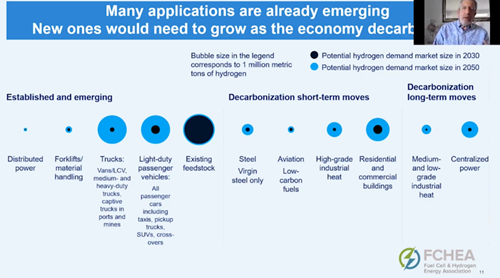News
H2Tech Solutions '21: FCHEA President outlines H2 roadmap for U.S.
Morry Markowitz, President of the Washington, D.C.-based Fuel Cell and Hydrogen Energy Association (FCHEA), gave a keynote talk on Day 2 of H2Tech's H2Tech Solutions conference about scaling up low-carbon hydrogen and fuel cell use in the U.S.
Markowitz noted that hydrogen and fuel cells have been receiving political and investment attention in the U.S. the past few years, and especially from the Biden administration.
"There has been a recognition that hydrogen energy and fuel cell technology will play a necessary, key role in the efforts to reduce emissions, both for the environment and for carbon reduction," Markowitz said. "Hydrogen is playing a more important role in the consideration of policies by the Department of Energy, the Department of Transportation, the Environmental Protection Agency and even the White House."
In 2020, the FCHEA launched "The Roadmap to a U.S. Hydrogen Economy." This strategy plan, which was supported by 20 organizations and companies, examines the potential for a hydrogen economy in the U.S. by 2030 and 2050.
Markowitz also explained the five major uses of hydrogen—power generation and grid balancing, transportation, fuel for industry, feedstock for industry, and heat for buildings. The diversity of the five uses are mirrored in the approach used by the Department of Energy in its H2@Scale project, which in turn mirrors various regional hydrogen development programs in the EU, the UK, Asia and Australia.
The broad range of applications for hydrogen "…really shows the diversity and the capabilities that hydrogen energy and fuel cell technology can play in addressing what we will need to do over the next 5, 10, 20 and 30 years to meet the goals of the Paris Accord," Markowitz noted.

The U.S. market currently consumes 11.4 million metric tons of hydrogen per year at a cost of $17.6 billion. California is the world's largest light-duty fuel cell electric vehicle market, with 45 retail hydrogen refueling stations in operation and 135 more in development.
"Batteries may be a good short-term solution" to some energy storage needs, Markowitz noted, "but hydrogen is becoming a clearer answer to the challenges of being able to convert renewable power, extract hydrogen and store it, and then use it in the future to stabilize our grid when the wind doesn't blow and the sun doesn't shine—and, in addition, to add to other uses such as transportation."
According to the plan laid out in the FCHEA's Roadmap, up to 14% of U.S. total energy demand could come from hydrogen in 2050. To get to that level, cost reductions will be needed in renewable energy and fuel cell stacks. The electric grid will also need to be expanded and converted to accommodate greater volumes of renewable energy, which will need to be exported from remote areas where it is produced to population-dense areas.

H2Tech Solutions runs from May 18–19 and on demand for one year after the event. To view the entirety of Morry Markowitz's presentation, please visit www.H2-TechSolutions.com to view the event agenda and register for live and on-demand access to all speaker presentations. If you have already registered for the conference, please use the personalized link delivered to your email to access the conference platform and speaker presentations.

